Works on the connection of the cable from the LEP pillar before the introductory junction box should be carried out by a specialized organization: it is too responsible for this section. Nevertheless, you need to decide with the input method - air or underground - as well as the type of cable and its cross section. So you have to deal with how you can connect electricity from the post to home and choose your own option.
Air electrician
Air method of power supply is attractive in that it does not require high time and money. But the standards are established by the requirements that are not all at home:
- Entering the cable to the house should be located at an altitude of at least 2.75 m. If the height of the house is enough, the distribution panel with the Uzo is mounted on the wall, the cable from the pillar is connected to it. If the house has a smaller height, set a special rack (pipe wall). It can be a curved form call "Hussak" (in the figure on the left) or straight (in the figure on the right). These two methods of input and attachment method to the walls of the house are distinguished (see photo).
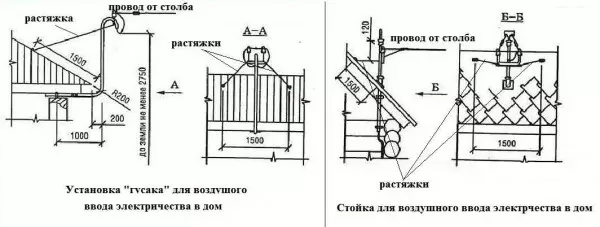
Methods for installing racks for air input of electricity in the house
- From the pillar to the input point, the distance should not exceed 10 m. If this distance is more, put additional support. From it to the power line, the distance should not be more than 15 m.
- Removal from the Lamp do:
- up to 10 m - copper wire cross section 4 mm;
- From 10 to 15 m - with a wire with copper veins section 6 mm.
- Aluminum wires are used in any case at least 16 mm in diameter.
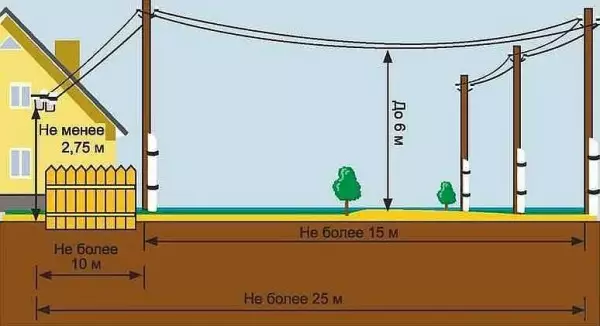
Connect to power post air
Although copper wires require smaller diameter, they cost much more than aluminum. Therefore, the entry of electricity into the house from the post is most often made from cables with aluminum veins. There are two ways:
- Between the pillars pull the torso or wire, to it on special clamps to attach a cocked cable.
- Use self-supporting wires for which the support is not needed: SIP (self-supporting wire isolated). It is connected using:
- insulators (glass, polymeric, porcelain);
- special fittings.
Special fittings appeared not so long ago, but becomes more and more popular. It has a certain margin of safety. When it is exceeded (falling of trees, a mass occurrence of snow, etc.) the valve is destroyed, but the cable remains intact, the power supply is not violated.
From the place where the introductory cable touches the wooden wall of the house, and to the installation site of the shield, the cable must be laid in the steel pipe
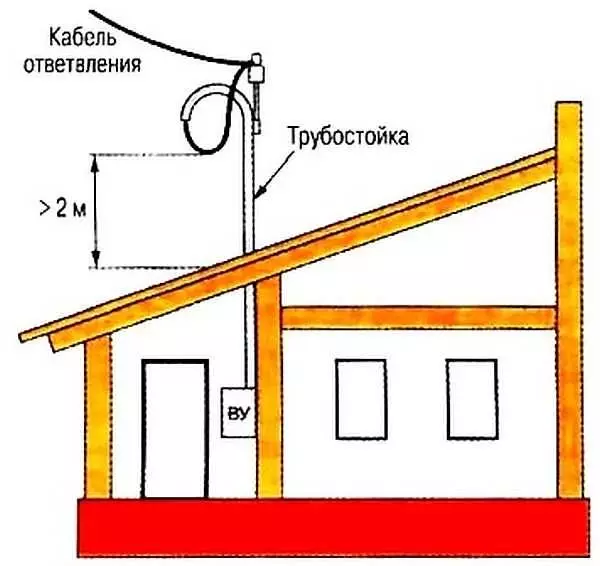
Entering electricity to house from a post through a pipe
Air input to the house has disadvantages:
- Wiring is open, due to which its damage is possible.
- The hanging wires limit the possibilities for the entrance of large equipment (autocranxes, auto-tesys, etc.).
Underground (trench) Entry of electricity
Another way to make an input of electricity to the wooden house - underground, through a trench.
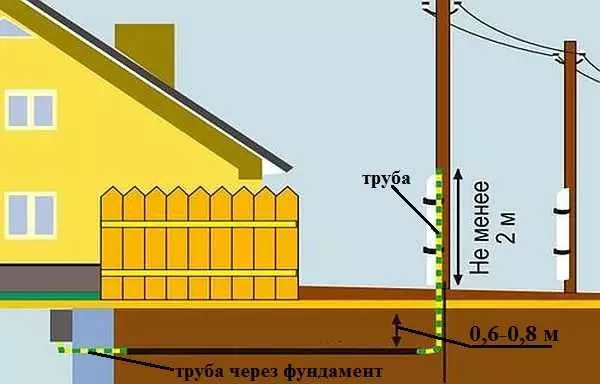
Entry of electricity in a wooden house through a trench
In this case, the cable on the post is lowered inside the steel pipe, its height should be at least 2 m from the ground level. Then, from the post to the place of entry into the house, the trench rushes. Her depth:
- 0.7 meters, when laying a cable in a plastic or asbestos tube or under the protection of a brick (concrete) plate
- 1 m - without protection.
Power cable enters the house too in a metal tube. It can be carried out through the foundation (tape), but not for it. The second option is to raise the pipe along the wall at least 2 meters, and at this height spend across the wall, and also in the metal pipe.
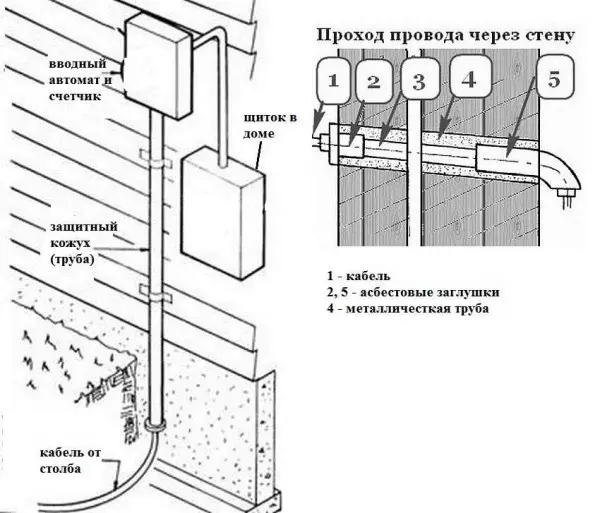
Method of Wiring Wiring through the outer Wooden Wall
When underground connection to the post, it is recommended to use a power cable with copper conductors in reinforced isolation, better - armored. When the power consumed, less than 15 kW constraints on the cross section of copper no lives, but most often the WBBSHB cable with residential 10 square millimeters is used.
All these works - up to the power supply to the power meter and its sealing - should conduct a special organization. An independent connection is prohibited, and even threatens with fines: a consistent project is required and a certain level of admission. But choose the type of connection, and then all the other work on the installation of wiring in the house - you can make it yourself.
How to collect electrical panels read here. It will be useful to read both the rules for connecting wires in the junction boxes.
Entering cable through a wooden wall of the house or foundation
If a sip or other conductor with aluminum veins is laid from the post to a wooden house, according to PUE, it is impossible to enter it into the house: "The laying of cables with aluminum veins on combustible designs is not allowed." We need to go to copper. More often than others for this purpose is used by the WGG cable - in non-combustible isolation.
It should be remembered that terminal boxes are used to connect the two of these conductors, an ordinary twist is unacceptable. The connected direct copper and aluminum enter into an active chemical reaction, quickly and strongly oxidize, which worsens contact. As a result, even with minor loads at the junction site, a spark appears, and this is a direct path to the fire. Therefore, the use of terminal boxes must. They are in hermetic case, there are open. For use on the street, understandable, it is better sealed, in the house you can put both open.

How to connect copper and aluminum wire
But that's not all. Through a wooden wall, the power cable can be carried out only through the steel pipe with a thick wall. The diameter of the pipe must be at least 4 times the outer diameter of the wire. The wall thickness is normalized (SP 31-110-2003) and should be no less:
- 2.8 mm for cable cross-section of 4 kV core. MM.
- 3.2 mm for cables with 6-10 kV veins. mm.
It is desirable to position the inlet that the water does not register inside. To seal the entry and exit sites, as well as to provide electrical safety, you can use asbestos, rubber or plastic plugs. The edges of the pipe will need to be carefully processing and stabbed to full smoothness so that the cable does not pass and its shell is damaged.
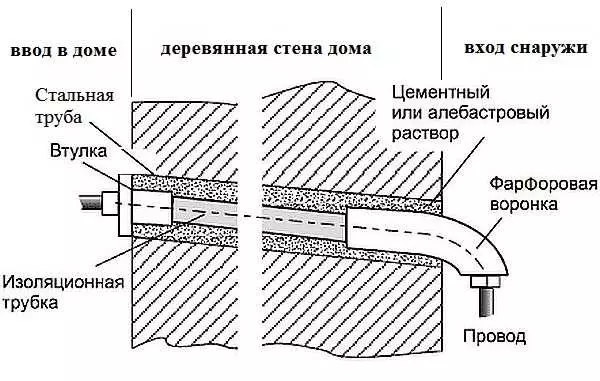
Entering an electrical cable through a wooden wall of the house
To calm and to increase the reliability of the segment, which will be inside the pipe, can be cooled asbestos thread or other insulating material. It can also fill the space inside the pipe so that there are no insects there. Another option is to fill the pipe with cement or alabastra.
On how to make wiring in a wooden house, read here.
When entering through the foundation, the situation is slightly different: the design is no longer considered to be combustable, so you can use plastic mortgages. They are installed at the stage of manufacturing a belt foundation. In this case, the passage for the cable differs depending on which the premises the cable falls: wet or dry.

Entering an electrical cable through the foundation of the house
Spare parts needed to organize safe entry electricians to the house, are not very much, but significantly increase the reliability, electrical and fire safety of your housing. Constructions are completely simple, with their device can cope with your own hands.
Article on the topic: wallpaper Abstraction for walls: interior options
